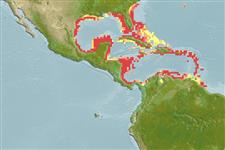Common names from other countries
Classification / Names / Names
Namen | Synonyme | Catalog of Fishes (gen., sp.) | ITIS | CoL | WoRMS
Environment: milieu / climate zone / depth range / distribution range
Ökologie
Riff-verbunden; tiefenbereich 0 - 40 m (Ref. 847). Tropical; 33°N - 8°N, 98°W - 50°W (Ref. 847)
Western Atlantic: Gulf of Mexico and Caribbean Sea.
Length at first maturity / Size / Gewicht / Alter
Maturity: Lm ? range ? - ? cm Max length : 0.5 cm CORD Männchen/unbestimmt; (Ref. 847)
Colonies are compact or prostrate clumps of short, thin, highly fused branches. Usually tan with dark calices.
Zooxanthellate (Ref. 116012). Found in shallow environments (Ref. 847).
Life cycle and mating behavior
Geschlechtsreife | Fortpflanzung | Ablaichen | Eier | Fecundity | Larven
Members of the class Anthozoa are either gonochoric or hermaphroditic. Mature gametes are shed into the coelenteron and spawned through the mouth. Life cycle: The zygote develops into a planktonic planula larva. Metamorphosis begins with early morphogenesis of tentacles, septa and pharynx before larval settlement on the aboral end.
Collin, R., M.C. Díaz, J. Norenburg, R.M. Rocha, J.A. Sánchez, M. Schulze, A. Schwartz and A. Valdés. 2005. (Ref. 415)
IUCN Rote Liste Status (Ref. 130435)
CITES Status (Ref. 108899)
Not Evaluated
Nutzung durch Menschen
| FishSource |
Tools
Mehr Information
Alter/GrößeWachstumLänge-GewichtLänge-LängeMorphologieLarvenDichte
Internet Quellen
Estimates based on models
Preferred temperature
(Ref.
115969): 23.6 - 28, mean 26.2 (based on 216 cells).
Preiskategorie
Unknown.
